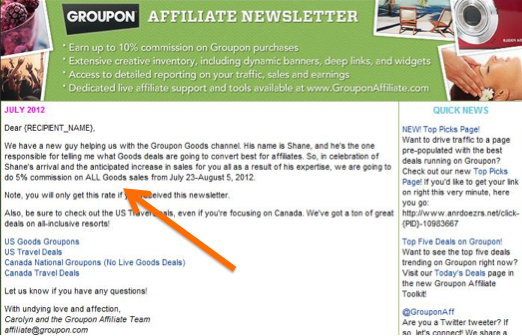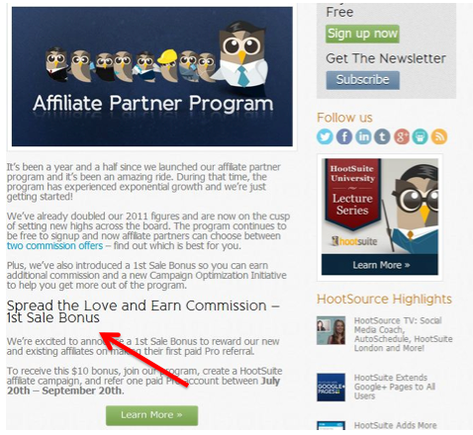Ecommerce executives often gauge the success of an affiliate program by how many affiliates have signed up. This is misleading.
I’d much rather oversee a program with 25 active and engaged affiliates driving traffic and sales, than thousands of affiliates who aren’t generating any activity. It’s not enough that you have the widest inventory or the best prices. If affiliates aren’t engaged with your program, they’re not going to promote your goods. Remember, many affiliates participate in hundreds of other affiliate programs. You need to ensure that your store and your brand remain important to them.
One way to do this is to run promotions designed to draw the affiliate’s attention — either to your program or to a particular product or category of your products. Here are a few promotions that use as affiliate marketing manager at Groupon.
1. Fixed Bonus for Achieving a Sales Threshold
Traditionally, an affiliate base is divvied up into three groups: top tier, middle tier, and bottom tier. Top tier performers drive high sales volume. You likely don’t need to incentivize them to drive traffic, because they’ve already integrated your program onto their sites and perhaps you’ve already negotiated custom terms for guaranteed placement. However, you want to increase the number of top tier performers. To do that, you need to motivate your bottom and middle tiers to perform better, so they will become top tier performers, too.
Middle tier affiliates may have your offers on their sites. They’re driving traffic and sales occasionally, but not consistently. They haven’t spent the time to optimize your brand on their sites. Analyze the top ten affiliates in your middle tier. How far away are they from being in your top tier? Let’s say your top tier partners are driving $5,000 in monthly sales, and the top affiliates in your middle tier are hovering around $3,000. Perhaps you reach out to them personally, and offer them an additional $500 bonus if they exceed $5,000 in monthly sales. You’d be spending a little more, but you’re getting at least an additional $2,000 in sales. Further, once affiliates see that your products can convert higher, the affiliates are likely to continue performing at that level the following month. While it seems like a short-term strategy, you’re aiming to build a long-term relationship.
Setting individual thresholds for affiliates is time intensive. You’re reaching out to each affiliate individually. You’re generating reports for specific affiliates. You’re awarding the $500 bonus for some affiliates, but not others. If you don’t have time for this, then try a similar promotion on a broader scale. Take the same middle tier affiliates and offer an additional $100 bonus on top of the standard commission if they increase sales by 20 percent. This way, instead of sending out individualized emails, you’re emailing a group. You’re “batch calculating” bonuses and you’ll be able to “batch upload” bonuses. Either way, the objective is the same: Get affiliates to optimize your brand on their sites.
2. Increased Commission on Products
Sometimes you have excess inventory — or perhaps a new product category — to draw attention to. In this case, it isn’t as critical to limit your promotion to a specific affiliate or tier of affiliates.
Instead of paying a fixed bonus, increase commission on a particular product or category of products. Let’s say you just started stocking, for the first time, products related to the back-to-school season. When affiliates start their own back-to-school campaigns, they’re likely not considering your company since you were previously not relevant to this season. By sending a newsletter with an offer of “Double Commission on Back To School Items,” you are not only notifying your affiliates that you have those products, but you’re also rewarding them to do something about it. Many affiliates will already have back-to-school promotions planned. This gives your products a chance to be included.
Depending on your affiliate network, awarding double commissions on a subset of products may require some manual work on your end. You would need to determine which affiliates sold what products, and then calculate their additional commissions. There are automatic ways of calculating this with many networks, which can assign commission rates to each product feed.
Recent Groupon email to affiliates, offering a specific commission percentage on all products. Enlarge This Image
Enlarge This Image
3. First Sale Bonus
Affiliates who haven’t driven any traffic or sales may not have integrated your program onto their sites. A good way to get an affiliate initially engaged is to offer a first sale bonus, such as, “I’ll give you a $5 bonus to drive just one sale between now and the end of the month.” This could encourage your affiliates to at least get your banners up. Affiliates could abuse that by shopping through their own links and completing a purchase. But even so, they browsed your site and learned about your products.
To account for this potential abuse, many affiliate managers offer a bonus on the second sale, not the first. However, I see value in getting affiliates to interact with a retailer’s site. So I’m more likely to structure something like, “I’ll give you a $5 bonus on your first sale, and an additional $5 on top of that for your second sale.”
Hootsuite, the social management platform, offered a "first sale" bonus in this newsletter. Enlarge This Image
Enlarge This Image
Summary
There are many ways to structure affiliate promotions. The best approach is to clearly define what you’re trying to achieve, and decide whether a fixed bonus or a commission bump will work best.




